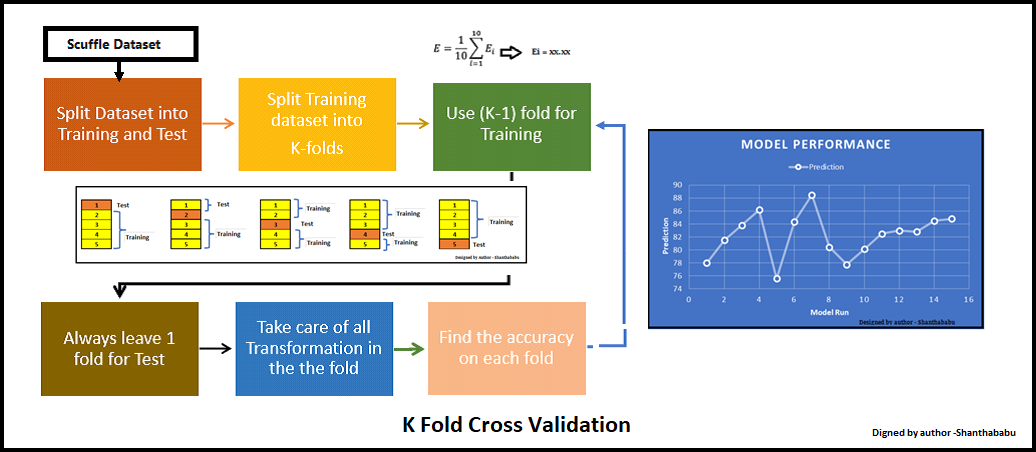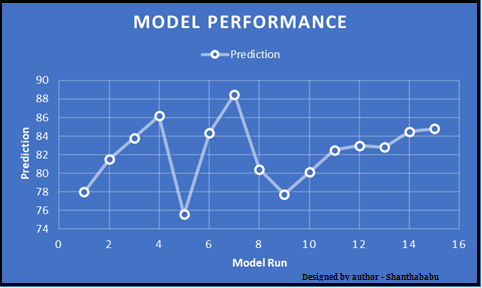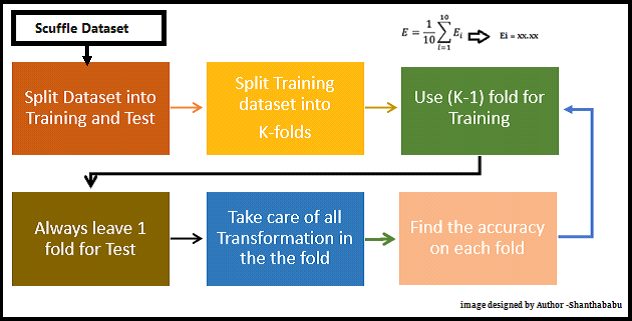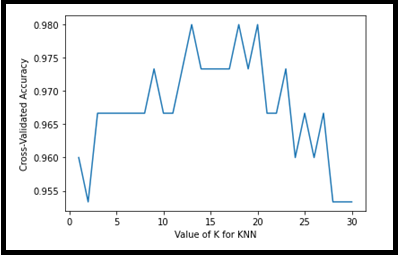K-Fold Cross Validation Technique and its Essentials
Introduction
Welcome to this comprehensive guide on model evaluation and selection techniques in machine learning, particularly focusing on K-fold cross-validation and its application in time series analysis. Before delving into the specifics, let’s consider the importance of these techniques in monitoring model performance before deployment. Understanding the performance metrics such as mean squared error, which evaluates the deviation between predicted and observed values, is crucial in ensuring model accuracy. We will explore how K-fold cross-validation, especially in the context of time series data, helps in training and validating models using multiple train-test splits.

By employing K-fold cross-validation, with features like test_index and train_index, we can mitigate overfitting and understand how the model generalizes to unseen data. Furthermore, we will examine the role of neural networks in classification tasks, highlighting their application in subsamples and their ability to learn complex patterns. Join us on this journey to optimize your machine learning models and enhance their performance.
Learning Outcomes
- Understand the concept of n_splits in K-fold cross-validation and implement K-fold cross-validation with different values of n_splits.
- Discuss how the choice of n_splits affects the model evaluation.
- Explain the significance of random_state in machine learning models.
- Discuss how setting random_state ensures reproducibility of results.
- Implement random_state in scikit-learn for various classifiers and regression models.
- Implement various machine learning algorithms using scikit-learn.
- Understand the importance of stratified k-fold cross-validation in classification problems.
- Discuss the advantages and limitations of train-test split compared to other validation techniques.
- Implement various classifiers (e.g., SVM, Random Forest, Logistic Regression) using scikit-learn.
- Discuss strategies for handling new data in machine learning models.
This article was published as a part of the Data Science Blogathon.
Table of contents
- Introduction
- What is Accuracy of the Model and Performance?
- ML Engineers and Business Team Agreement
- What is K-Fold Cross Validation?
- Life Cycle of K-Fold Cross-Validation
- Thumb Rules Associated with K Fold
- Basic Example
- Model Selection usi ng K-Fold
- Parameter Tuning Using K-Fold
- K-Fold in Visual form
- Conclusion
- Frequently Asked Questions
What are Model Performance and its necessity?
Machine learning model performance assessment is just like assessing the scores, how we used to evaluate our sores in high schools and colleges for the meeting the eligibility criteria for getting the best courses or getting selected in the campus interviews for companies for the job and clearing cut-off scores for many more competition exams for getting selected. So apparently, the GOOD score recognizes the fact that the candidate is always good. The same is been expected in the machine learning model, and that should achieve the expected results in predictions/forecasting/calcification problem statements. Even in the ML world, the model has been trained in the context of data, model, and code.
What is Accuracy of the Model and Performance?
The accuracy of a model in data science is computed as a metric to understand how well it performs in predicting outcomes. It measures the proportion of true predictions made by different models built using available data records. To achieve robust performance, these models are trained across various combinations of data, ensuring they can generalize well to new data and improve accuracy.
ML Engineers and Business Team Agreement
As we know, there are various methods to evaluate model performance. It is our team’s responsibility to construct a robust and generalized model that meets production expectations. Additionally, we need to effectively communicate its performance and the business benefits to stakeholders and customers, guided by SMEs, to achieve our goals.
As we are an ML engineer team, we must provide the performance of the model in the numeric range. Let’s say the performance of the model would be 85-90%. Sometimes the performance of the model in training and testing will not behave the same in production, in many cases, Overfitting or Underfitting will be experienced during the production environment.
Yes! Of course, this is really threatening to junior Data scientists and ML Engineers, but the challenge is one requires to improvise your technical capabilities, right? , So after many iterations and CI/CD involvement (MLOps), only the model will achieve the accuracy as expected and in a generalised mode. One step further, always we have to monitor the performance and apply the necessary changes to the model algorithm and code.
Will see how we could overcome this in the real-time, scenario.
As I mentioned earlier the RANGE-Factor, we have different techniques to evaluate, in which Cross-Validation or K – Fold Cross Validation is best and easy to understand. This is simple in nature and involves a typical resampling technique, without any replacement in the data. And easily we could understand and visualise while implementing.

Image designed by the author
What is K-Fold Cross Validation?
K-fold cross-validation is a powerful technique for evaluating predictive models in data science. It involves splitting the dataset into k subsets or folds, where each fold is used as the validation set in turn while the remaining k-1 folds are used for training. This process is repeated k times, and performance metrics such as accuracy, precision, and recall are computed for each fold. By averaging these metrics, we obtain an estimate of the model’s generalization performance. This method is essential for model assessment, selection, and hyperparameter tuning, offering a reliable measure of a model’s effectiveness. Compared to leave-one-out cross-validation, which uses k equal to the number of samples, K-fold cross-validation is computationally efficient and widely used in practice.
In each set (fold) training and the test would be performed precisely once during this entire process. It helps us to avoid overfitting. As we know when a model is trained using all of the data in a single short and give the best performance accuracy. To resist this k-fold cross-validation helps us to build the model is a generalized one.
To achieve this K-Fold Cross Validation, we have to split the data set into three sets, Training, Testing, and Validation, with the challenge of the volume of the data.
Here Test and Train data set will support building model and hyperparameter assessments.
In which the model has been validated multiple times based on the value assigned as a parameter and which is called K and it should be an INTEGER.
Make it simple, based on the K value, the data set would be divided, and train/testing will be conducted in a sequence way equal to K time.
Life Cycle of K-Fold Cross-Validation

Image designed by the author
Let’s have a generalised K value. If K=5, it means, in the given dataset and we are splitting into 5 folds and running the Train and Test. During each run, one fold is considered for testing and the rest will be for training and moving on with iterations, the below pictorial representation would give you an idea of the flow of the fold-defined size.

Image designed by the author
In which each data point is used, once in the hold-out set and K-1 in Training. So, during the full iteration at least once, one fold will be used for testing and the rest for training.
In the above set, 5- Testing 20 Training. In each iteration, we will get an accuracy score and have to sum them and find the mean. Here we can understand how the data is spread in a way of consistency and will make a conclusion whether to for the production with this model (or) NOT.

Thumb Rules Associated with K Fold
Now, we will discuss a few thumb rules while playing with K – fold
- K should be always >= 2 and = to number of records, (LOOCV)
- If 2 then just 2 iterations
- If K=No of records in the dataset, then 1 for testing and n- for training
- The optimized value for the K is 10 and used with the data of good size. (Commonly used)
- If the K value is too large, then this will lead to less variance across the training set and limit the model currency difference across the iterations.
- The number of folds is indirectly proportional to the size of the data set, which means, if the dataset size is too small, the number of folds can increase.
- Larger values of K eventually increase the running time of the cross-validation process.

Please remember K-Fold Cross Validation for the below purpose in the ML stream.
- Model selection
- Parameter tuning
- Feature selection
So far, we have discussed the K Fold and its way of implementation, let’s do some hands-on now.
Basic Example
I am creating a simple array, defining the K size as 5 and splitting my array. Using the simple loop and printing the Train and Test portions. Here we could see clearly that the data points in TT buckets and Test data are unique in each cycle.
Python Code:
You can see the Train and Test array and how the array got split in every iteration.
Let’s do this with the dataset.
Model Selection using K-Fold
from sklearn.linear_model import LogisticRegression
from sklearn.svm import SVC
from sklearn.ensemble import RandomForestClassifier
import numpy as np
from sklearn.datasets import load_digits
import matplotlib.pyplot as plt
digits = load_digits()
from sklearn.model_selection import train_test_split
X_train, X_test, y_train, y_test = train_test_split(digits.data,digits.target,test_size=0.3)imported required libraries and loaded digits (hand-written digits – open source), let’s apply a different algorithm.
Logistic Regression
I am using liblinear. This is the “Large Linear Classification” category. It uses a Coordinate-Descent Algorithm. This would minimize a multivariate function by resolving the univariate and its optimization problems during the loop.
lr = LogisticRegression(solver='liblinear',multi_class='ovr')
lr.fit(X_train, y_train)
lr.score(X_test, y_test)Output
Score : 0.972222
SVC
Just using gamma is a parameter for non-linear perspective for hyperplanes. The value of the gamma tries to fit the training data set and uses 1/n_features.
svm = SVC(gamma='auto')
svm.fit(X_train, y_train)
svm.score(X_test, y_test)Output
Score : 0.62037
Random Forest
For RFC, I am assigning estimators as 40.
rf = RandomForestClassifier(n_estimators=40)
rf.fit(X_train, y_train)
rf.score(X_test, y_test)Output
Score: 0.96666
Scores from the above list of algorithms Logistic Regression and Random Forest are doing comparatively better than SVM.
Now will use cross_val_score function and get the scores, passing different algorithms with dataset and cv.
from sklearn.model_selection import cross_val_score
Set LogisticRegression, CV =3
score_lr=cross_val_score(LogisticRegression(solver='liblinear',multi_class='ovr'), digits.data, digits.target,cv=3)
print(score_lr)
print("Avg :",np.average(score_lr))Output: for 3 fold we have 3 scores
[0.89482471 0.95325543 0.90984975] Avg : 0.9193099610461881
Set SVM and CV=3
Output: Scores
[0.38063439 0.41068447 0.51252087] Avg : 0.4346132442960489
Set Random Forest and CV=3
Output: Scores
[0.92821369 0.95325543 0.92320534] Avg : 0.9348914858096827
| Before K Fold apply | After K Fold applied (Avg) | |
| Logistic Regression | 97% | 91% |
| SVM | 62% | 43% |
| Random Forest | 96% | 93% |
Based on the above table, we will go with Random Forest for this dataset for production. But we have to monitor the model performance based on the data drift and as the business case changes, we have to revisit the model and redeploy.
Parameter Tuning Using K-Fold
Let us consider the RandomForestClassifier for this analysis, and n_estimators is our parameter for this case and CV as 10 (commonly used)
Output
Avg Score for Estimators=5 and CV=10 : 0.87369
Output
Avg Score for Estimators=20 and CV=10 : 0.93377
Output
Avg Score for Estimators=30 and CV=10 : 0.94879
Output
Avg Score for Estimators=40 and CV=10 : 0.94824
| scores1 | 87.36% |
| scores2 | 93.33% |
| scores3 | 94.87% |
| scores4 | 94.82% |
Based on the above observation, we will go with Estimators=30.
K-Fold in Visual form
Visual representation is always the best evidence for any data which is located across the axes.
from sklearn.model_selection import cross_val_score
knn = KNeighborsClassifier(n_neighbors=5)
scores = cross_val_score(knn, X, y, cv=10, scoring='accuracy')
print(scores.mean())Output
0.9666666666666668
k_range = list(range(1, 25))
k_scores = []
for k in k_range:
knn = KNeighborsClassifier(n_neighbors=k)
scores = cross_val_score(knn, X, y, cv=10, scoring='accuracy')
k_scores.append(scores.mean())
print(k_scores)
Output
[0.96, 0.95333, 0.96666, 0.96666, 0.966668, 0.96666, 0.966666, 0.966666, 0.97333, 0.96666, 0.96666, 0.97333, 0.9800, 0.97333, 0.97333, 0.97333, 0.97333, 0.98000, 0.9733333, 0.980000, 0.966666, 0.96666, 0.973333, 0.96, 0.96666, 0.96, 0.96666, 0.953333, 0.95333, 0.95333]
import matplotlib.pyplot as plt
%matplotlib inline
plt.plot(k_range, k_scores)
plt.xlabel('Value of K for KNN')
plt.ylabel('Cross-Validated-Accuracy')
Output: With a simple plot, X=> value of K and Y=> Accuracy for respective CV

The above visual representation helps us to understand the accuracy is ~98%for K=12,18 and 19 for KNN.
Conclusion
Employing K-fold cross-validation enables a comprehensive evaluation of model performance by partitioning the entire dataset into K equal-sized subsets. This method allows us to mitigate the impact of imbalanced data and provides reliable cross-validation results for deep learning models. By selecting the appropriate hyperparameters based on these results, we can optimize model performance and enhance its generalization ability across the entire dataset.
Key Takeaways
- The test dataset is crucial for evaluating the performance of a trained model on unseen data, ensuring it generalizes well beyond the training set.
- After training a model on the training data, it’s essential to evaluate its performance on both the validation and test datasets to ensure it meets performance expectations.
- Validation data helps in tuning model hyperparameters and assessing the model’s performance before finalizing it for deployment.
- The KFold class from the sklearn.model_selection module is instrumental in splitting the data into K folds for cross-validation, ensuring robust model evaluation and preventing overfitting.
Frequently Asked Questions
A. K-fold cross-validation is a technique used in machine learning and statistical modeling to evaluate the performance of a predictive model. It involves dividing the dataset into k subsets or folds of approximately equal size. The model is then trained and evaluated k times, each time using a different fold as the validation set and the remaining folds as the training set. The performance metrics obtained from each fold are averaged to provide a more robust estimate of the model’s generalization performance. Common values for k are 5 and 10, but other values can also be used depending on the dataset size and complexity.
A. K-fold cross-validation assesses a machine learning model’s performance and generalization ability by splitting the dataset into k equal-sized subsets (folds). During each iteration, k-1 folds are used for training, and the remaining fold is used for validation. Performance metrics like accuracy, precision, and recall are calculated for each fold and averaged to obtain a robust estimate of the model’s performance. This method helps in selecting the best model or hyperparameter settings and mitigates overfitting risks. Finally, the selected model is evaluated on a separate test set for a final performance estimation.
The choice of k (number of folds) in k-fold cross-validation depends on the dataset size and desired bias-variance trade-off. Common values are k=5, k=10, and k=20. For smaller datasets, use k=5 or k=10. For larger datasets, use k=10 or k=20. Consider computational resources, model complexity, and cross-validation goals when choosing k.
The media shown in this article is not owned by Analytics Vidhya and are used at the Author’s discretion.









Q1 Can Stratified k-fold split be committed on the same dataset wherein we commit Train-Test Split? Q2 How do we initiate Data Scaling/Data Normalization/Data Transformation on a k-fold split? Is this step done post the split or before k-fold split? Reference codes would be useful.
Hello @Shanthababu . I think this is one of the best articles I have read so far on "K-Fold Cross Validation". All the images that you used in your blog are self-explanatory and awesomely explain the concept, and then reading the theory part is extra topping on that. Thank you, Shanthababu. Please keep up the good work and do not try to dishearten yourself.